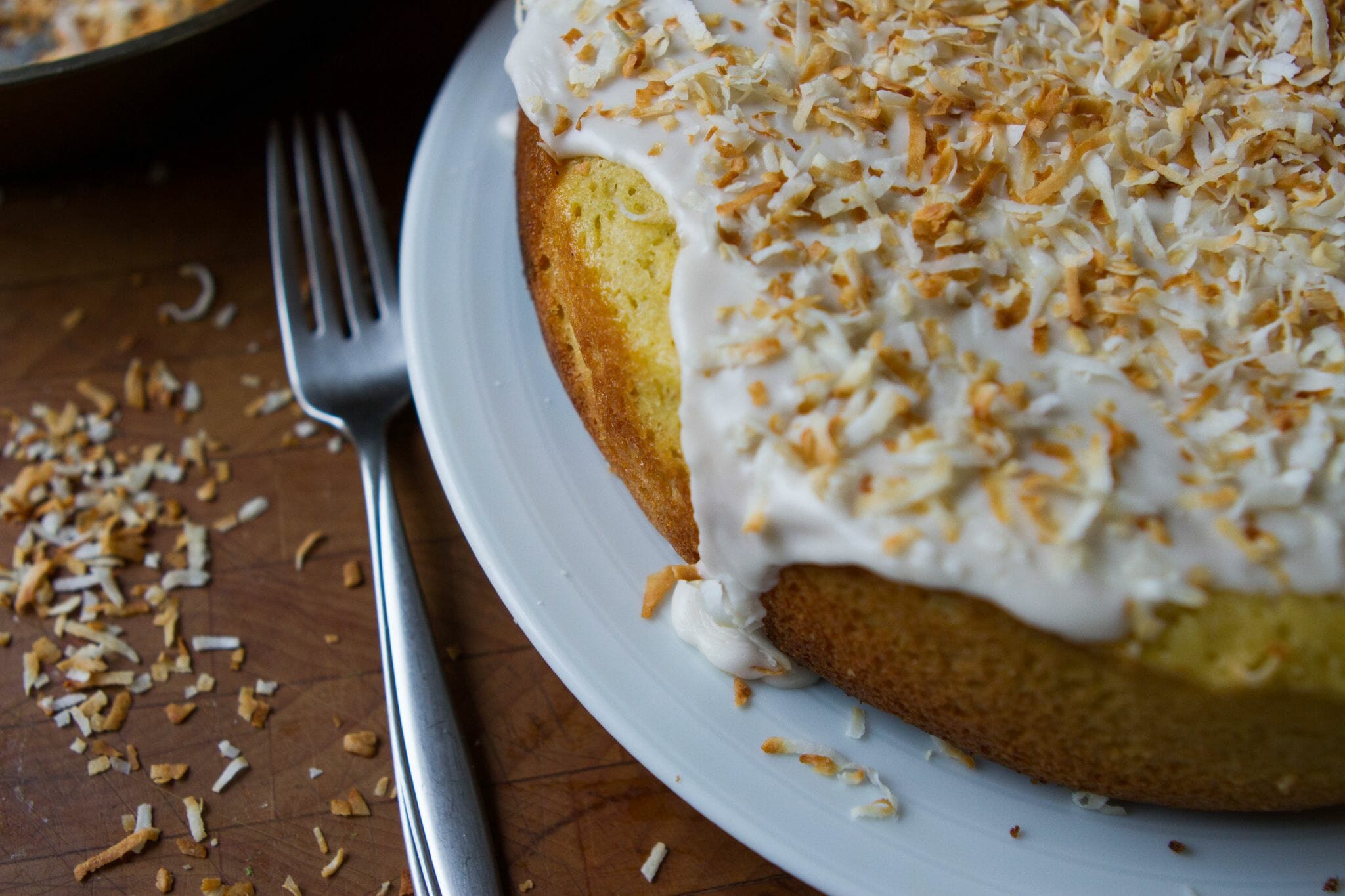Author’s note: Before we get to the important stuff (likely cake or booze or something roasted slowly over an open fire, because what else is more important?) let us quickly clarify that this column on food is not about how to do it the easy way. Ordering it ready-made is the easy way. Baking it in your five-star kitchen is also easy. This is about cooking your own way – on the road, by the river, in a camper – which is also known as doing it the hard way. Sometimes, part of being an angler means being hard-headed. We talk about anglers being eternal optimists. But they are also stubborn cusses who don’t know when to pack it in and call it a day.
Such is the case here.
Last time I went ice fishing, I asked myself a very important question.
No, not why.
Rather, “how.”
As in, “how could I make this better?”
Surprising to me, but maybe not my subconscious, the answer came rather quickly.
Cake.
Cake could make ice fishing better.
And not just any cake. Tropical cake. The kind that makes you feel like you’re tasting sunshine and getting adequate amounts of vitamin D.
Coconut was perfect. Lime was even better. Rum was necessary.
Three days later, I loaded my triple layered, gawdy coconut confection into a spare box, stowed it next to the ice fishing sled and hopped in the truck, neglecting the basic principles of physics in my haste to get out the door.
When I opened the tailgate, it looked as though a giant pigeon had swooped in and taken a dump all over the back. Layers sprawled across the cardboard, coconut poking through sticky icing, that, rather than set in a pillowy quaff, drooped off the side of the cake like a depressed and flabby Michelan Man.
“Any cake is better than no cake when ice fishing? Right?”
No.
No… It’s not.
When I opened the tailgate, it looked as though a giant pigeon had swooped in and taken a dump all over the back. Layers sprawled across the cardboard, coconut poking through sticky icing, that, rather than set in a pillowy quaff, drooped off the side of the cake like a depressed and flabby Michelan Man.
Dry, crumbly, dense, flavorless layers dressed up in icing that looked like a marshmallow that had been dropped on the ground and then smeared all over the sides. No, any cake is not always better than no cake.
This year, I set to remedy that disaster. And in the process, I baked another disaster. Finally, after the last bits of scorch were scraped from the pan, I discovered what might be the best bite of sunshine you’ll pull out of the dungeon-colored sides of a Dutch oven in a never-ending Montana winter — a riff on a traditional olive oil cake, substituting coconut oil for olive.
Vacation in a bite.
The beauty of an olive oil cake — or in this case, a coconut oil cake — is the lack of pretention and fussiness. The mixture contains enough moisture that it will not lose its mind and go all drama queen on you should your timing or heat be a bit off. Not to mention, it lacks the need for special equipment. By adding the twist of coconut and lime zest, a baker can elevate what might otherwise be overlooked as bland or boring.
Traditionally, the basic principles of cake baking involve whipping lots of butter and sugar. You might have seen the instruction “Cream the butter and the sugar?” This creates an ethereal microscopic structure where sharp sugar crystals cut into fat molecules, trapping air bubbles and giving you lofty rise.
The trick for preserving that lofty structure, however, lies in the heat. Too hot and the exterior sets before the interior. Too cool and the batter will set slowly, causing the cells to coalesce and creating a heavy texture.
If a fire pit is more your style, then heat can be much more difficult to manage. In this case, less is more, both when it comes to heat and when it comes to the mechanics of creating that microscopic structure. By using an oil-based recipe, or in this case, a coconut oil-based recipe, you’re eliminating much of the heavy lifting that you might otherwise lean on an electric mixer to do in to making those sublime chemical connections.
One final thought on Dutch oven confectionary creations: After an atomic meltdown where I burned the exterior of the cake so badly, I could quite literally bake the interior within it as if it were a flour-based pottery shell (and did… and ate it… not great, but not bad), I switched to charcoal to help moderate the heat. Baking in a Dutch oven can be finicky, especially in the winter when the cold air can fiddle with the temperature of your “oven.”
Which leads me to one bit of unsolicited advice: Don’t take any baking time as gospel.
Trust your gut, use your nose and let your inner pyro take the lead. And as for high-class ice fishing… maybe next year. I don’t think this cake will make it to the pickup before disappearing and I’m not sure sweatpants are appropriate attire for an afternoon on the ice.
What you’ll need and how to do it
This recipe adapted from Jennifer Davis’s Coconut Lime Cake recipe on food52.com
Gear:
Dutch oven and tools for managing coals
Charcoal
Parchment paper
Ingredients:
For the cake:
2 cups all-purpose flour
1-3/4 cup sugar
1-1/2 teaspoon kosher salt
1/2 teaspoon baking soda
1/2 teaspoon baking powder
1-1/2 tablespoon grated lime zest
3/4 cup coconut oil, warmed to liquid
1-1/4 cup full-fat coconut milk
3 eggs room temperature
1/4 cup fresh lime juice
1/4 cup coconut rum
Top with whipped cream, whipped coconut cream or for a sweeter cake, top with frosting.
For coconut frosting:
1-1/2 cup powdered sugar
2-3 tablespoons reserved coconut milk
1 teaspoon vanilla
1/2 teaspoon coconut extract
Pinch of salt
Toasted coconut for topping
- Prepare your bed of coals. Charcoal works best for this recipe.
- Grease and then line your Dutch oven with parchment paper using two long strips placed like a cross in the bottom (you will use these to lift out the cake) and a round the size of the bottom of the pan to keep the base from sticking. If you are serving in the Dutch oven, skip the long strips.
- Mix flour, sugar, salt, baking soda, baking powder and lime zest. Stir.
- In a separate bowl, mix coconut oil, coconut milk, eggs, lime juice and coconut rum.
- Add dry ingredients and stir gently until just combined – batter may be lumpy.
- Pour batter into Dutch oven. Set aside 6-8 coals for the top of the oven. Place the cake so it rest 2-3 inches above the coals to prevent the bottom from scorching. Try to manage your heat so it is evenly distributed. Place the 6-8 coals on the top.
- Bake for about 20 minutes before lifting the lid to check for doneness.
- Once cake tester comes out clean, remove from coals and lift cake out to cool. If you want to leave it in the Dutch oven to serve, remove from coals just before cake is done as the heat of the oven will continue to cook the cake.
- Mix together ingredients for frosting and top cooled cake, finishing with a sprinkle of toasted coconut.



